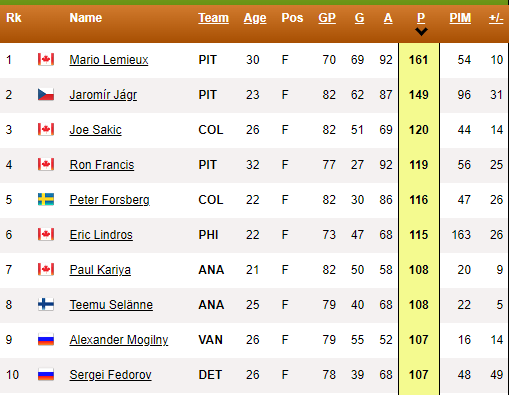Obviously, scoring stats from 1953 can't be compared to stats from 1996. The two most obvious reasons are 1996 was a much higher-scoring season, and the schedule was longer. (Granted, both Howe and Lemieux played 70 games, but Lemieux missed a dozen games while Howe didn't miss any).
With those two basic adjustments, Howe's 95 points are comparable to approximately 95 * 82/70 * 3.14/2.40 = 146 points. Lemieux is still ahead, and he achieved this in fewer games, but now they're in the same ballpark (taking into account Howe's physicality and much strong two-way play).
Assists are a subtler point that need to be considered. Not many people realize that during the 1950's, the NHL awarded fewer assists per goal compared to the modern NHL. Leaguewide, there were 1.66 assists per goal in 1996, but only 1.50 assists per goal in 1953. Applying this adjustment and Howe is up to 154 adjusted points (75 goals, 78 assists).
Another subtle point is the split between ES, PP and SH scoring. Surprisingly, 1996 only featured about 13% more goals per game at ES compared to 1953. But there was a massive difference in scoring on the powerplay (it was 90% higher in 1996 compared to 1953). Unfortunately we don't have enough data to tell if more powerplays were being called in 1996, if powerplays were more successful (ie a higher percentage resulted in a goal), or some combination of both. But for Lemieux, a player who by 1996 got a significant portion of his points on the powerplay, this is a huge advantage. He wouldn't have come close to putting up the same scoring totals in 1953 because PP goals were much less common back then. (Shorthanded offense was also far more common in 1996 - 121% more goals per game compared to 1953 - but since this is a relatively small part of offense, it doesn't have a huge impact).
Here's my best estimate of what Lemieux's production would have looked like, scaling everything back to 1953:
[TABLE=collapse]
[TR]
[TD]SEASON[/TD]
[TD]ES G[/TD]
[TD]ES A[/TD]
[TD]PP G[/TD]
[TD]PP A[/TD]
[TD]SH G[/TD]
[TD]SH A[/TD]
[TD]Goals[/TD]
[TD]Assists[/TD]
[TD]Points[/TD]
[/TR]
[TR]
[TD]Howe (1953)[/TD]
[TD]37[/TD]
[TD]30[/TD]
[TD]11[/TD]
[TD]16[/TD]
[TD]1[/TD]
[TD]0[/TD]
[TD]49[/TD]
[TD]46[/TD]
[TD]95[/TD]
[/TR]
[TR]
[TD]Lemieux (1996)[/TD]
[TD]23[/TD]
[TD]30[/TD]
[TD]14[/TD]
[TD]19[/TD]
[TD]3[/TD]
[TD]0[/TD]
[TD]40[/TD]
[TD]49[/TD]
[TD]89[/TD]
[/TR]
[/TABLE]
Of course I'm not saying that Lemieux would have scored exactly 89 points (no more, no less) in 1953. But it's a ballpark estimate that helps adjust for context (just like we need to do if we're comparing dollars to Euros, or prices from today to prices from 30 years ago).
Based on this, I think it's accurate to say that Howe (1953) and Lemieux (1996) were in the same ballpark offensively. Even after all of these adjustments, Lemieux was a bit more productive per game (by about 9%), but Howe was a far better all-around player (especially at this point in their respective careers). I don't think it's controversial to say that Howe's best season is at least equal to what might be Lemieux's 4th best season.




